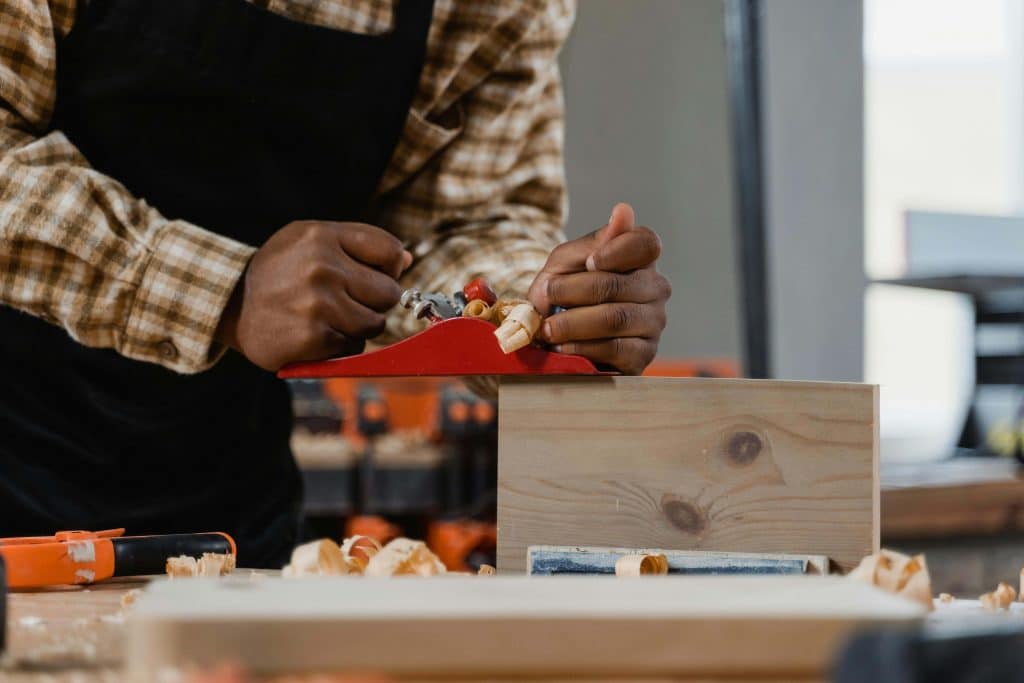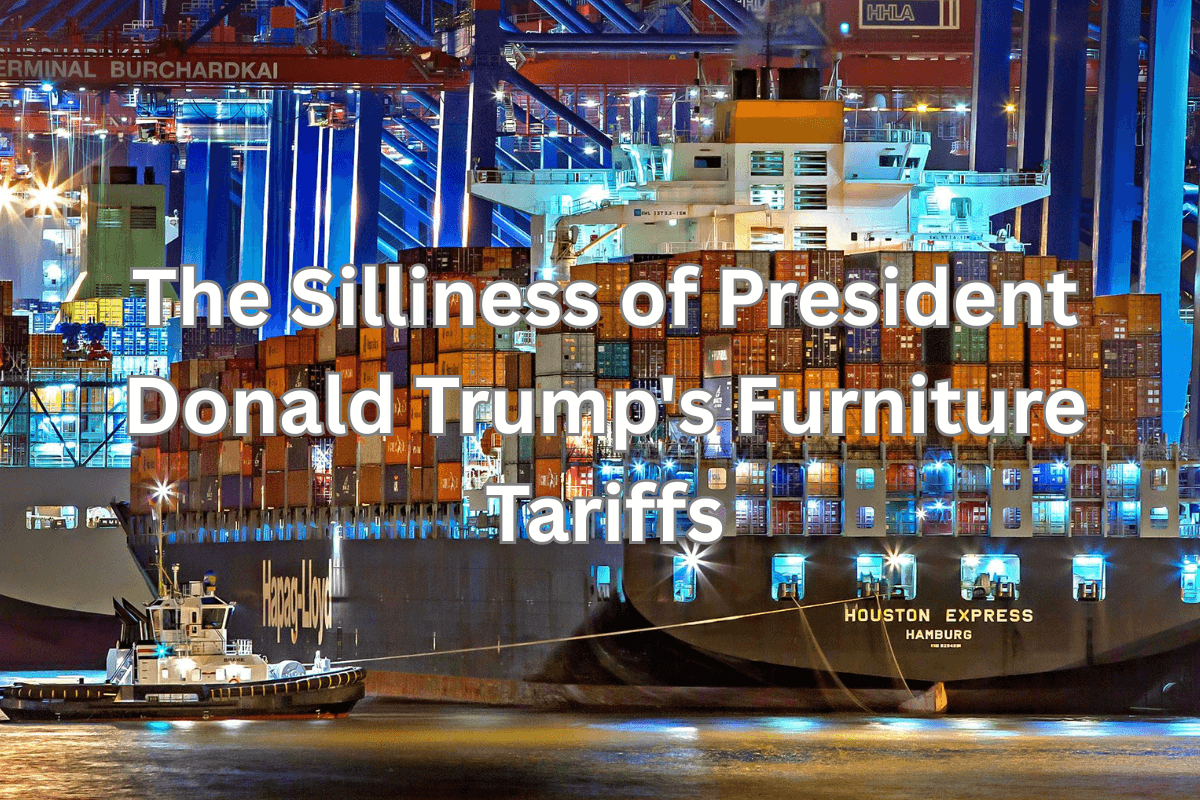I just listened to President Donald Trump deliver his speech about how furniture manufacturing will return to states like North Carolina, South Carolina, and other regions like “magic.” He proclaimed that the remaining skilled furniture workers should start teaching their children and grandchildren the craft of furniture making right now!
I swear I have never heard anything quite so silly and ridiculous in my life. Obviously, President Trump and the members of his cabinet have not spent much time making furniture or working on the floor of a furniture factory. I certainly have spent most of the last 30 years of my life doing exactly that, so I know quite a bit about what furniture production and what furniture manufacturing really entails.
Table of Contents
- The Myth of Available Skilled Workers
- Knowledge-Based Manufacturing Complexities
- Machinery Challenges
- Regulatory Reality
- Historical Precedent
- The Investment Reality
- Related Content
Here are some of the reasons why I call this move completely and totally silly.
The Myth of Available Skilled Workers
Trump seems to believe that skilled workers will suddenly appear out of nowhere—that they are just sitting at home waiting to return to factory work. This is not necessarily the case.
Years ago we used to create many hand-painted items for furniture and accessories. At the time, China had numerous skilled hand painters, so this type of work was quite inexpensive.
They were able to execute extremely detailed hand painting at very reasonable prices. Then suddenly, trends changed, and people no longer wanted hand-painted items. Those hand-painting workers left and found other jobs.
Recently, I went back to explore hand painting again, trying to find someone to produce some hand-painted items. I couldn’t find any hand painters, and the few that remained were extremely expensive. Why? Because now there are so few workers who know how to do hand painting that they can command extremely high prices.
This is an example of what’s happening all over the world, especially in places like China, where once there were many workers able to produce something, but now there are very few skilled workers, making production using those skills very expensive.
I’m really not sure how Trump and his cabinet think that this law of economics—this law of worker availability—doesn’t apply to America. He seems to have this view that somehow there are all these skilled woodworkers just waiting to get back into the factory. This may not be the case.

Furthermore, when he tells these workers to start teaching their children and grandchildren, he’s making several assumptions.
First, he’s assuming that these children and grandchildren want to spend their days on a furniture factory floor making furniture. In my experience, most of them probably do not.
The other assumption he’s making is that even the silled furniture factory workers want their children doing this work.
Even in China, many furniture factory workers don’t want their children working in furniture factories. They want their children to have higher-skilled jobs such as banker, lawyer, or doctor. They don’t envision their children being the ones producing furniture.
Knowledge-Based Manufacturing Complexities
Like most manufacturing, furniture is also knowledge-based manufacturing. In other words, you don’t just need workers—you also need workers who have the knowledge and skill to produce a quality product.
Let’s think for a minute about furniture and some of the skills you’ll need.
Kiln-Dried Wood
A lot of furniture requires kiln-dried wood. You need someone who understands wood. You might be able to get the wood already kiln-dried, which sometimes happens here in Asia, and that would help.
However, if you have a hurricane or storm that comes through and moisture gets into the wood, you need someone who understands what temperature the wood should be so it won’t crack and how to properly dry the wood.
This has happened to us many times here in Asia, where we’ve had to bring parts or pieces of furniture back into a kiln to bring the wood down to the required moisture content. If you don’t have a kiln on-site, this becomes much more complicated.
Veneers
If the furniture uses veneer, then you need someone who understands veneer application and having a veneer press within the factory, especially if it’s a larger operation is ideal. You need someone with the skill to understand how to press the veneer against MDF or other woods.
But if you have very special veneer—like some of the custom veneers we work with that are specially made or hand-applied—this becomes much more complicated and costly.
I can’t even imagine what the cost would be to have someone sit in an American factory hand-applying veneer piece by piece.
Construction
Good furniture requires good construction, and good construction requires knowledge. This is where, many times in Asia, we look to a factory to have this kind of understanding because the factory has been doing so much production.
The factory usually understands the best way to handle construction challenges. You need to find someone to hire who has that set of knowledge and skills to help ensure you can produce a quality piece of furniture at scale.
This may seem simple, but it may not be as easy as it appears.
Finishes
Finishing is where furniture production becomes very complicated. The finishes we do can follow a 6 to 10-step or more process—meaning there are 10 or more steps to the actual finish.
Americans are now used to many of these complicated finishes where maybe the wood has one finish and the base has another. They’re used to having these in-depth finishes, not just spray paint, especially for quality furniture.
Many of the finishes we do are hand-applied, meaning that distressing and other effects are placed on the furniture by hand. You would need to find someone with the skill to understand how to apply these techniques at scale to really operate a furniture factory.
With the furniture finishes, we haven’t even talked about really high-skilled finishes like lacquer, gold leafing, hand carving, hand weaving, etc. I wouldn’t even want to guess how much it would cost to produce this kind of product completely in the United States, or where you would find the skilled workers who want to do this kind of work.
Hardware, Parts, and Pieces
Over the years, much of the hardware parts and pieces of furniture manufacturing has gone overseas, especially to places like China, where they’re able to produce wonderful hardware at very good prices. This means that US manufacturers will more than likely end up having to import these products from somewhere else, and they’re going to cost more.
Why will they cost more? Well, because there are tariffs on steel and aluminum, so many of these items will be subject to higher tariffs, making them much more expensive.
You might say, “Well, just produce them in the United States.” But does someone have the machinery? Do they have the ability? Do they have the workers and other resources to produce the required hardware?
Fabric
Fabric is another area to consider as some furniture as sofas require textile materials.
There used to be many mills in the United States. I remember in the early 1990s selling fabric from the United States to places like Thailand, but this has all changed.
Most of the fabric mills producing furniture textiles are now in China, India, and other places. They have the machinery, equipment, skills, and labor. I don’t see this being easy to bring back at scale.

Machinery Challenges
Anyone starting from scratch to build a furniture factory in the USA today will more than likely need to import most of their machinery, and that machinery will come from overseas—most likely China.
But China has tariffs on anything imported, including steel or aluminum, so that machinery will land in the United States at a higher cost than if sold into other countries.
Simply put, this means the United States will start their production at a disadvantage. The machinery will cost them more, so they will need to amortize that into their production costs at a higher rate than other countries need to.
Regulatory Reality
A major change has been happening in China. In areas that used to be full of furniture factories, there are now high-tech companies.
The workers have moved out of the furniture industry and into the high-tech industry, and the furniture factories have moved elsewhere. Why? Often because of local regulations.
Furniture manufacturing is not always a clean business. It’s not like working in a tech company where you can almost eat off the floor.
In furniture product there is wood dust, wood chips, spray paint, and other materials. Even if the US eliminates many regulations, there will still be some regulations that factories must follow, just like factories here in Asia are required to have.
Historical Precedent
If we go back in history, we can remember 2005, when many US companies pursued China for anti-dumping violations regarding bedroom furniture. This essentially stopped almost all bedroom furniture production in China.
These major US furniture companies said they needed this protection to be competitive and keep jobs in America.
I don’t think many jobs actually stayed in America after this action. Instead, it’s well known that the industry shifted to places like Vietnam, the Philippines, and now India.
I’m not sure of the exact reason, but I assume it was because even in 2005, producing furniture in the United States was simply too costly. If it was costly then, why is today different? Is it different just because President Donald Trump wishes it to be?
The Investment Reality
If I were looking at starting a furniture factory in the United States, I’m not sure it would be a good investment at this time. The risks and costs would be very high.
But one thing I know for sure is that this will not happen just like “magic,” as President Trump claims, nor do all the former woodworkers in America want to teach their children and grandchildren the craft—unless they are Amish and already producing furniture in the United States. The Amish do some wonderful production, but even the Amish cannot handle all the furniture production the US requires for their furniture and home décor needs.
Mr. President, putting tariffs on furniture is really very, very silly.
The furniture industry is a complex ecosystem that has evolved over decades. It requires not just workers, but skilled craftspeople with specialized knowledge.
It needs supply chains for materials, hardware, and components that have been optimized globally. It demands significant capital investment in machinery and equipment, much of which would need to be imported at higher costs due to existing tariffs.
Most importantly, it requires market forces and economic incentives that currently favor overseas production for good reasons—not just labor costs, but expertise, infrastructure, and established supply networks.
Waving a magic wand and declaring that furniture production will return to America ignores these fundamental economic realities. It’s not just silly—it’s a disservice to the workers and communities who deserve realistic solutions, not empty promises of magical transformations.
The furniture industry didn’t leave America overnight, and it won’t return overnight either. Any serious effort to rebuild domestic furniture manufacturing would require a comprehensive, long-term strategy that addresses all these challenges—not just tariffs and wishful thinking.
Until our leaders understand the true complexity of modern manufacturing, we’ll continue to see policies that sound good in speeches but fail to deliver real results for American workers and consumers.
Deep Dive Podcast -Beyond the Magic Wand: Why Furniture Tariffs Will Not Revive an Industry
Listen to our podcast called Beyond the Magic Wand: Why Furniture Tariffs Will Not Revive an Industry.
Find out more about how Mondoro can help you create, develop, and manufacture excellent home decor and furniture with trade and ethical sourcing in mind – don’t hesitate to contact me, Anita. Check out my email by clicking here or become a part of our community and join our newsletter by clicking here.
Mondoro gives out a FREE Lookbook to anyone interested. You can receive a copy of our latest Lookbook by clicking here.
Listen to our Podcast called Global Trade Gal. You can find it on all major podcast platforms. Try out to listen to one of our podcasts by clicking here.
Subscribe to our Mondoro Company Limited YouTube Channel filled with great videos and information by clicking here.
Related Content
What Are The Major Benefits Of Strategic Sourcing?
Never underestimate the proper use of the strategic sourcing process in your supply chain. Strategic sourcing is a significant benefit to all stakeholders within the supply chain. Strategic sourcing forces all stakeholders to look at the supply chain strategy in detail. Strategic sourcing helps to eliminate any potential risks or problems.
You can discover more by reading What Are The Major Benefits Of Strategic Sourcing? by clicking here.
Seven-Step Strategic Sourcing Process Explained
A seven-step strategic sourcing strategy process will help companies be successful when looking to procure a product or a commodity. If companies take the time to go through each of the seven steps, this will help them to ensure they are successful with their sourcing needs.
You can find out more by reading our blog Seven-Step Strategic Sourcing Process Explained by clicking here.
Product Sourcing and Strategic Sourcing Explained
Product sourcing is when you source or look to find a supplier for a product you need. Strategic sourcing is strategically sourcing products. Strategic sourcing is not about the lowest purchase price but the lowest overall cost. Product sourcing and strategic sourcing are very similar, but strategic sourcing is sourcing with a plan in place.
You can learn more by reading Product Sourcing and Strategic Sourcing Explained by clicking here.

